#YearInSpace Reddit AMA
#YearInSpace Reddit AMA
NASA astronaut Scott Kelly and Russian cosmonaut Mikhail Kornienko will return from a year-long mission to the International Space Station on Tuesday, March 1. Research conducted during this mission will help prepare us for future voyages beyond low-Earth orbit.

On Friday, March 4 at 11 a.m. EST, we will host a Reddit AMA with scientists and medical doctors from our Johnson Space Center. During the AMA, they will answer your questions about everything from how microgravity affects the human body to how astronauts’ food intake is closely monitored while on-orbit. Ask us anything about the science behind the One Year Mission!
Participants include:
Julie Robinson, Ph.D., NASA’s Chief Scientist for the International Space Station
John Charles, Ph.D., Associate Manager for International Science for NASA’s Human Research Program
Scott M. Smith, Ph.D., Nutritional Biochemistry Laboratory Manager for NASA’s Human Research Program
Dr. Shannan Moynihan, NASA Flight Surgeon
Bruce Nieschwitz, Strength and Conditioning Coach
Join us on Reddit here
Make sure to follow us on Tumblr for your regular dose of space: http://nasa.tumblr.com
More Posts from Nasa and Others
What is it Like to Visit Jupiter?
Jupiter is the largest planet in our solar system. For some perspective, if it were hollow, more than 1,300 Earths could fit inside of it! The giant planet contains two-thirds of all the planetary mass in the solar system and holds more than dozens of moons in its gravitational grip. But what about a visit to this giant planet?

Let’s be honest…Jupiter is not a nice place to visit. It’s a giant ball of gas and there’s nowhere to land. Any spacecraft – or person – passing through the colorful clouds gets crushed and melted. On Jupiter, the pressure is so strong it squishes gas into liquid. Its atmosphere can crush a metal spaceship like a paper cup.

Jupiter’s stripes and swirls are cold, windy clouds of ammonia and water. Jupiter’s Great Red Spot is a giant storm BIGGER THAN EARTH! This storm has lasted hundreds of years.

Since Jupiter’s atmosphere is made up of mostly hydrogen and helium, it’s poisonous. There’s also dangerous radiation, more than 1,000 times the lethal level for a human.
Scientists think that Jupiter’s core may be a thick, super hot soup…up to 50,000 degrees! Woah!
The Moons

Did you know that Jupiter has its own “mini solar system” of 50 moons? Scientists are most interested in the Galilean satellites – which are the four largest moons discovered by Galileo Galilei in 1610.
Today, Galileo would be astounded to know some of the facts about these moons. The moon Io has active volcanos. Ganymede has its own magnetic field while Europa has a frozen crust with liquid-water underneath making it a tempting place to explore for future missions.

When Juno arrives to Jupiter on July 4, it will bring with it a slew of instruments such as infrared imager/spectrometer and vector magnetometer among the half a dozen other scientific tools in its payload.
Juno will avoid Jupiter's highest radiation regions by approaching over the north, dropping to an altitude below the planet's radiation belts – which are analogous to Earth’s Van Allen belts, but far more deadly – and then exiting over the south. To protect sensitive spacecraft electronics, Juno will carry the first radiation shielded electronics vault, a critical feature for enabling sustained exploration in such a heavy radiation environment.
Follow our Juno mission on the web, Facebook, Twitter, YouTube and Tumblr.
Make sure to follow us on Tumblr for your regular dose of space: http://nasa.tumblr.com
Black Hole Sculpts an Hourglass Galaxy
When it comes to galaxies, our home, the Milky Way, is rather neat and orderly. Other galaxies can be much more chaotic. For example, the Markarian 573 galaxy has a black hole at its center which is spewing beams of light in opposite directions, giving its inner regions more of an hourglass shape.

Our scientists have long been fascinated by this unusual structure, seen above in optical light from the Hubble Space Telescope. Now their search has taken them deeper than ever — all the way into the super-sized black hole at the center of one galaxy.
So, what do we think is going on? When the black hole gobbles up matter, it releases a form of high-energy light called radiation (particularly in the form of X-rays), causing abnormal patterns in the flow of gas.
Let’s take a closer look.

Meet Markarian 573, the galaxy at the center of this image from the Sloan Digital Sky Survey, located about 240 million light-years away from Earth in the constellation Cetus. It’s the galaxy’s odd structure and the unusual motions of its components that inspire our scientists to study it.

As is the case with other so-called active galaxies, the ginormous black hole at the center of Markarian 573 likes to eat stuff. A thick ring of dust and gas accumulates around it, forming a doughnut. This ring only permits light to escape the black hole in two cone-shaped regions within the flat plane of the galaxy — and that’s what creates the hourglass, as shown in the illustration above.

Zooming out, we can see the two cones of emission (shown in gold in the animation above) spill into the galaxy's spiral arms (blue). As the galaxy rotates, gas clouds in the arms sweep through this radiation, which makes them light up so our scientists can track their movements from Earth.

What happens next depends on how close the gas is to the black hole. Gas that’s about 2,500 light-years from the black hole picks up speed and streams outward (shown as darker red and blue arrows). Gas that’s farther from the black hole also becomes ionized, but is not driven away and continues its motion around the galaxy as before.

Here is an actual snapshot of the inner region of Markarian 573, combining X-ray data (blue) from our Chandra X-ray Observatory and radio observations (purple) from the Karl G. Jansky Very Large Array in New Mexico with a visible light image (gold) from our Hubble Space Telescope. Given its strange appearance, we’re left to wonder: what other funky shapes might far-off galaxies take?
For more information about the bizarre structure of Markarian 573, visit http://svs.gsfc.nasa.gov/12657
Make sure to follow us on Tumblr for your regular dose of space: http://nasa.tumblr.com
Hi.dr.naomi.i have 2 questions.
1.Can this JAMES WEB T.S able to see Mercury, Venus and certain stars that are close to the sun either. I.
2.Why is the James Webb t.s.mirror yellow?
Any specific reason for this
What's Up? - May 2018

What’s Up For May?
The Moon and Saturn meet Mars in the morning as our InSight spacecraft launches to the Red Planet on May 5!

You won't want to miss red Mars in the southern morning skies this month.

InSight, our first mission to explore Mars' deep interior, launches on May 5th with a launch window that begins at 4:05 a.m. PDT and lasts for two hours.

Some lucky viewers in central and southern California and even parts of the Mexican Pacific coast will get a chance to see the spacecraft launch with their unaided eyes AND its destination, Mars, at the same time.

Mars shines a little brighter than last month, as it approaches opposition on July 27th. That's when Mars and the Sun will be on opposite sides of the Earth. This will be Mars' closest approach to Earth since 2003!

Compare the planet's increases in brightness with your own eyes between now and July 27th.

The Eta Aquarid meteor shower will be washed out by the Moon this month, but if you are awake for the InSight launch anyway, have a look. This shower is better viewed from the southern hemisphere, but medium rates of 10 to 30 meteors per hour MAY be seen before dawn.

Of course, you could travel to the South Pacific to see the shower at its best!

There's no sharp peak to this shower--just several nights with good rates, centered on May 6th.

Jupiter reaches opposition on May 9th, heralding the best Jupiter-observing season, especially for mid-evening viewing. That's because the king of the planets rises at sunset and sets at dawn.

Wait a few hours after sunset, when Jupiter is higher in the sky, for the best views. If you viewed Jupiter last month, expect the view to be even better this month!
Watch the full What’s Up for May Video:
There are so many sights to see in the sky. To stay informed, subscribe to our What’s Up video series on Facebook. Make sure to follow us on Tumblr for your regular dose of space: http://nasa.tumblr.com.
What are the most important skills an astronaut should have m?
First of all, the basic requirement is a bachelor’s degree in a STEM field, and 3 years of experience (which can also be substituted for by an advanced degree). Other than that, operational experience (things with a technical/active/hands on nature like flying airplanes, SCUBA diving, taking things apart and putting them back together, basic fix-it skills, etc. etc.) is very important, as this is an integral aspect of every day of a space mission. What we call “expeditionary skills” are also essential, basically the types of things you try to instill in your children, like how to play nicely with others, self care, team care, etc. I like to think about this on the lines of a camping trip and who you would like to have along with you . . .someone that is competent and can take good care of themselves and their equipment, someone that contributes to the team and helps with group tasks, someone that is good natured and pleasant to be around, etc., someone fun! These things are increasingly important now that we are regularly doing long duration missions (typical International Space Station mission is 6 months). Experience living in extreme/remote/isolated environments with small teams is also useful, as it is similar to what we experience as astronauts.
First All-Woman Spacewalk
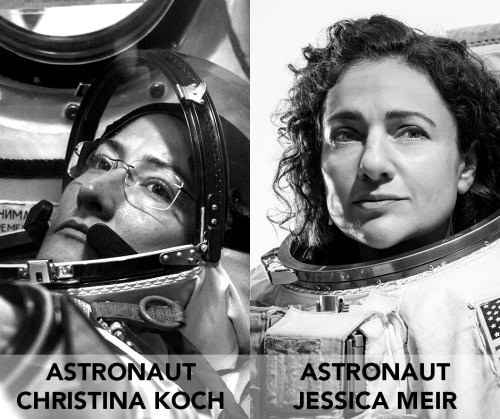
NASA astronauts and best friends, Christina Koch and Jessica Meir, made history Friday, October 18, 2019, by conducting the first all-woman spacewalk outside the International Space Station (ISS)! The Expedition 61 flight engineers ventured into the vacuum of space at 7:38 a.m. EDT to swap out a failed power controller that regulates the batteries used to collect and distribute power to the orbital laboratory – a task that took a total of seven hours and 17 minutes to complete.
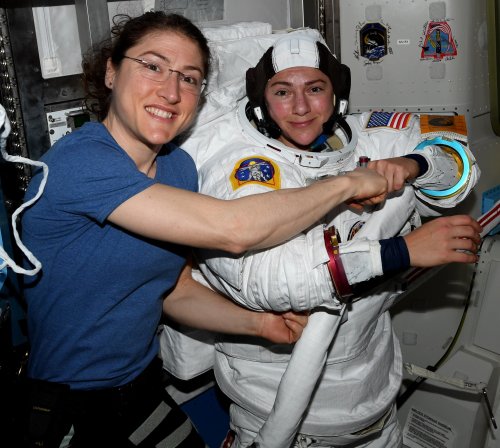
This was Koch’s fourth spacewalk and Meir’s first. Both women, selected as astronaut candidates in 2013, are on their first trip to work and live aboard the space station. Meir will be the 15th woman to spacewalk, and the 14th U.S. woman.
Get to know the astronauts
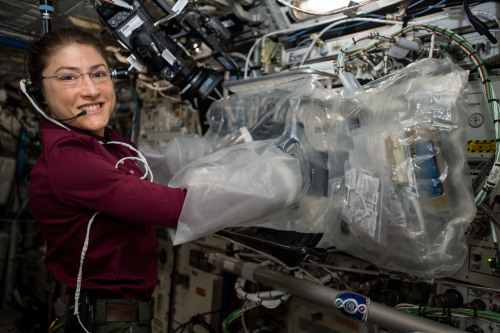
In addition to being an astronaut, Christina Koch is an engineer and physicist. Her career has taken her to extreme parts of the planet to conduct scientific field missions in places like the Antarctic South Pole and Greenland’s Summit Station. Prior to being selected as an astronaut candidate in 2013, she worked as an Electrical Engineer at our Goddard Space Flight Center’s Laboratory for High Energy Astrophysics.
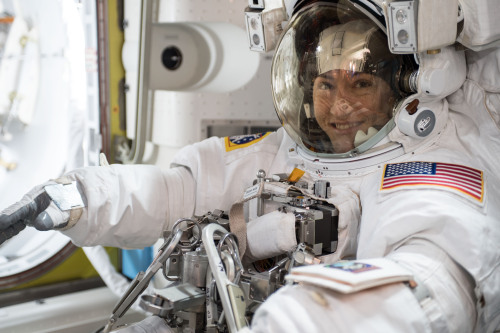
Koch left Earth on March 14, 2019, and is slated to set a record for the longest single spaceflight by a woman with an expected total of 328 days in space. Her extended mission will provide researchers the opportunity to observe the effects of long-duration spaceflight on a female body in preparation for human missions to the Moon and Mars.
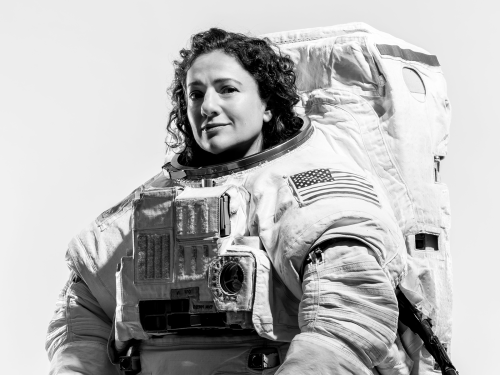
Jessica Meir dreamed of the day she would make it to space since the age of five. That dream became a reality on Wednesday, Sept. 25, 2019 as she left Earth on her first spaceflight – later floating into her new home aboard the International Space Station.
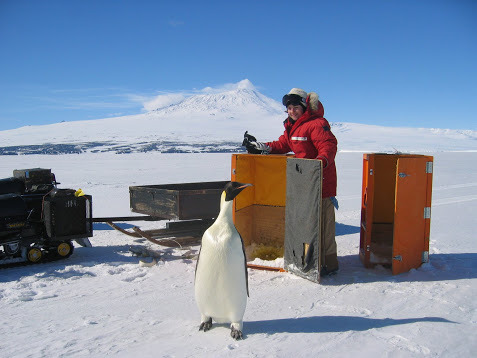
While Meir’s new home is more than 200 miles over the Earth, she is no stranger to extreme environments. She studied penguins in Antarctica and mapped caves in Italy – both of which prepared her for the ultimate extreme environment: space.
#AllWomanSpacewalk, what’s the deal?
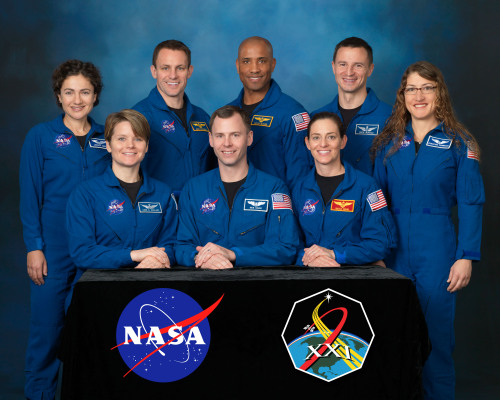
The all-woman spacewalk wasn’t something we purposefully planned; it is a testament to the increasing number of female astronauts in the space program. For example, Koch’s and Meir’s 2013 class of astronaut candidates was 50 percent women!
When asked in an interview about the importance of conducting her mission and this spacewalk, Koch said,
“In the end, I do think it’s important, and I think it’s important because of the historical nature of what we’re doing. In the past women haven’t always been at the table. It’s wonderful to be contributing to the space program at a time when all contributions are being accepted, when everyone has a role. That can lead in turn to increased chance for success. There are a lot of people who derive motivation from inspiring stories of people who look like them, and I think it’s an important story to tell.”
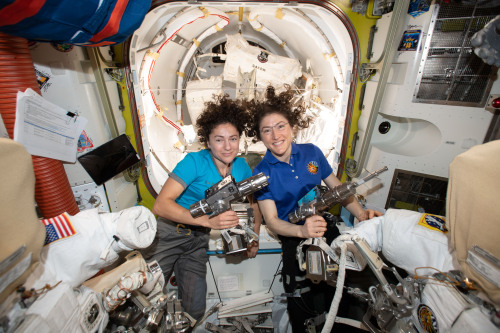
It’s important to note that spacewalks are not easy; astronauts typically describe them as the most physically challenging thing they do. Assignments are made on the basis of which astronauts are the best prepared to accomplish the tasks at hand under the conditions at the time. Today, Koch and Meir were the top astronauts for the job.
Women are no stranger to spacewalks!

While this was the first spacewalk to be conducted entirely by women, women are no strangers to spacewalks. Exactly 35 years and one week ago, Kathryn Sullivan (pictured above) made her own historic debut as the first U.S. woman to conduct a spacewalk. Since then, a total of 14 women (15 including Jessica) have ventured into the vacuum of space on 40 different spacewalks. Former Astronaut Peggy Whitson performed a record number of 10! From Astronauts to mission directors, women have been making their mark at the agency for decades now. A few of our recent pioneers are:
Astronaut Kate Rubins: First person to sequence DNA in space
Astronaut Peggy Whitson: First woman to command the ISS
Sandra Cauffman: Director of our Earth Science’s Division
Nicola Fox: Director of our Heliophysics Division
Lori Glaze: Director of our Planetary Science Division
Coming soon: The first woman to walk on the Moon
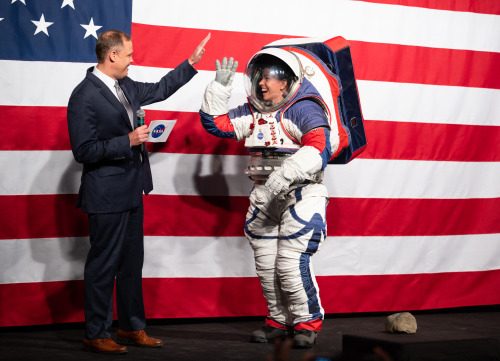
The first all-woman spacewalk is a milestone worth noting and celebrating as we look forward to putting the first woman and the next man on the Moon by 2024 with our Artemis lunar exploration program. With today’s historic event, we once again set a precedence for women to lead in space exploration.
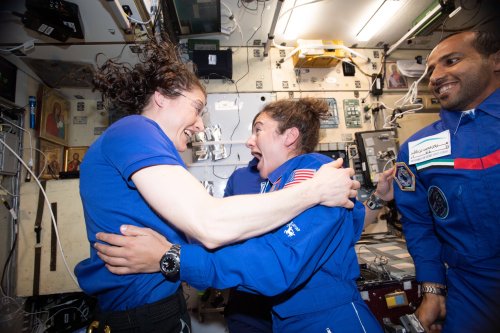
We hope achievements such as this provide inspiration to you all around the world, proving that hard work can lead you to great heights. This is not just a historic day for NASA, but a moment we can all feel proud of.
Didn’t have time to tune in? Check out the replay, here. Koch was wearing the spacesuit with red stripes, while Meir’s had no stripes.
If you’d like to keep up with Christian Koch and Jessica Meir’s work 254 miles above planet Earth, follow them on Twitter at @Astro_ Christina and @Astro_Jessica.
Be sure to follow us on Tumblr for your regular dose of space: http://nasa.tumblr.com

Ever want to ask a real life astronaut a question? Here’s your chance!
We are kicking off Hispanic Heritage Month a little early this year, and astronaut Serena M. Auñón-Chancellor will be taking your questions in an Answer Time session on Thursday, September 12 from 12pm - 1pm ET here on NASA’s Tumblr! Find out what it’s like to be a NASA astronaut and learn more about her Cuban-American heritage. Make sure to ask your question now by visiting http://nasa.tumblr.com/ask!
Dr. Serena M. Auñón-Chancellor began working with NASA as a Flight Surgeon in 2006 and was later selected as a NASA astronaut in 2009. Her first flight was from Jun 6- Dec. 20, 2018 where she served as Flight Engineer on the International Space Station as a member of Expeditions 56 and 57. During these missions, the crew contributed to hundreds of experiments in biology, biotechnology, physical science and Earth science – including investigations into a new cancer treatment!
She has a Bachelor of Science in Electrical Engineering from The George Washington University, Washington, D.C and a Doctorate of Medicine from The University of Texas - Health Science Center at Houston.
Dr. Auñón-Chancellor Fun Facts:
She spent 2 months in Antarctica from 2010 to 2011 searching for meteorites as part of the ANSMET expedition.
She served as an Aquanaut on the NEEMO 20 mission in the Aquarius underwater laboratory, which is used to prepare for living and working in space.
She logged 197 days in space during Expeditions 56 and 57.
Follow Serena on Twitter at @AstroSerena and follow NASA on Tumblr for your regular dose of space.
Solar System 10 Things to Know This Week: Humans of NASA
Meet some of the amazing humans behind our exploring machines.
1—Small Town to Small Satellites

“I grew up in a small town where working at NASA was unheard of. I worked hard, persevered, and eventually made it to where I am despite many obstacles along the way. Through that process, never forget to enjoy what you are doing. It is my passion for space exploration that has helped me keep motivated and that brings me happiness every day that I come to work.”
—Farah Alibay, Engineer
2—Scientist. Mountain Unicyclist

“I do a rather unusual sport for fun—mountain unicycling. I love it because it's incredibly challenging, requiring strength, stamina and focus. I also enjoy surfing, caving, flying and teaching a space camp in South Korea each summer.”
—Morgan Cable, Research Scientist
3—"Eat. Breathe. Do Science. Sleep later."

“I do SCIENCE! No, seriously, I travel and explore for fun. It's a fascinating world and I can't get enough of it. But I'm always doing "science" of some kind no matter where I am. I love it —— can't escape it and wouldn't want to. Eat. Breathe. Do Science. Sleep later.”
—Derek Pitts, Solar System Ambassador
4—In the Room Where It Happened

“It was the summer of 2013, when I was the media rep for the Voyager mission. I was with Ed Stone, the mission's project scientist, when he came to the conclusion that Voyager 1 had crossed the threshold into interstellar space. For the first time, a human—made object flew beyond the plasma bubble our sun blows around itself. Voyager 1 is now bathed in the remnants of the explosions of other stars. I really appreciated seeing the scientific process—and Ed’s mind—at work.”
—Jia-Rui Cook, Supervisor of News Events and Projects at JPL
5—All About the Math. And Determination.

"From an academic point of view, it's all about doing well in math and science. However, there is absolutely no substitute for being determined. Being determined to be successful is at least half the game."
— James Green, Director of NASA’s Planetary Science Division
6—Problem Solver

“Opportunity [rover] was designed to live for 90 days in the harsh Martian environment but she is still exploring now 11 years later! Because of her age, software and hardware components are degrading on the vehicle and more recently, the flash memory. I had the incredible opportunity to lead the team to figure out how to solve these flash problems and get Opportunity back into an operational state.”
—Bekah Sosland Siegfriedt, Engineer
7—Never Give Up

"When you encounter difficulties or failures, do not take no for an answer. If you truly want to accomplish something and are passionate about it, you need to believe in yourself, put your mind to it, and you can accomplish anything! I failed A LOT, but I NEVER GAVE UP. It took three years and over 150 applications to NASA before I received my first internship"
—Kevin DeBruin, Systems Engineer
8—More Than Mohawk Guy

"The great thing about being at NASA is that there are jobs for all types —— whether it's engineering, science, finance, communication, law, and so forth. All of them are necessary and all of them involve working on some of the coolest things humans can do. So pick the area you love, but also know that you can still be a part of exploring the universe."
—Bobak Ferdowsi, Systems Engineer
9—The Power of One

“When my older sister claimed she would one day be an astronaut, on the heels of Sally Ride's launch into space, I made the same claim. Though, it was more because I dreamed to be just like my sister! In turned out that she outgrew the crazy dream, and my desire only got stronger.”
—Mamta Patel Nagaraja, Science Communications
10—Dedication and Choices

“Body-building is a favorite pasttime: it's a great stress reliever and a hobby that I can take with me when I travel for work or for pleasure. It's also a great expression of responsibility and ownership: What I've accomplished is due entirely to my dedication and choices, and it belongs to no one but me.”
—Troy Hudson, Instrument System Engineer
Check out the full version of Ten Things to Know HERE.
Make sure to follow us on Tumblr for your regular dose of space: http://nasa.tumblr.com
Once in how much time does a solar eclipse happen?
It depends on where you are. You can check out our interactive map here https://eclipse2017.nasa.gov/sites/default/files/interactive_map/index.html

Who is the First Woman? Meet our new graphic novel hero!
Artemis is the first step in the next era of human exploration. This time when we go to the Moon, we're staying, to study and learn more than ever before. We’ll test new technologies and prepare for our next giant leap – sending astronauts to Mars.

Artemis missions will achieve many historic feats, like landing the first woman and first person of color on the Moon.
With today’s release of our graphic novel First Woman: NASA’s Promise for Humanity you don’t have to wait to join us on an inspiring adventure in space.
Meet Commander Callie Rodriguez, the first woman to explore the Moon – at least in the comic book universe.

In Issue No. 1: Dream to Reality, Callie, her robot sidekick RT, and a team of other astronauts are living and working on the Moon in the not-too-distant future. Like any good, inquisitive robot, RT asks Callie how he came to be – not just on the Moon after a harrowing experience stowed in the Orion capsule – but about their origin story, if you will.

From her childhood aspirations of space travel to being selected as an astronaut candidate, Callie takes us on her trailblazing journey to the Moon.

As they venture out to check on a problem at a lunar crater, Callie shares with RT and the crew that she was captivated by space as a kid, and how time in her father’s autobody shop piqued her interest in building things and going places.

Callie learned at a young age that knowledge is gained through both success and failure in the classroom and on the field.

Through disappointment, setbacks, and personal tragedy, Callie pursues her passions and eventually achieves her lifelong dream of becoming an astronaut – a road inspired by the real lives of many NASA astronauts living and working in space today.

So what's up with that lunar crater?
Did Callie pass her math class?
And where did RT come from?
Be a part of the adventure: read (or listen to) the full First Woman story and immerse yourself in a digital experience through our first-ever extended reality-enabled graphic novel.
Make sure to follow us on Tumblr for your regular dose of space!
-
 carpaltunnelhomeremedies-blog liked this · 7 years ago
carpaltunnelhomeremedies-blog liked this · 7 years ago -
 safouane-reus liked this · 9 years ago
safouane-reus liked this · 9 years ago -
 hotvalencia liked this · 9 years ago
hotvalencia liked this · 9 years ago -
 jsbustaman liked this · 9 years ago
jsbustaman liked this · 9 years ago -
 coinnews reblogged this · 9 years ago
coinnews reblogged this · 9 years ago -
 fatabulousme reblogged this · 9 years ago
fatabulousme reblogged this · 9 years ago -
 mikalrkayn liked this · 9 years ago
mikalrkayn liked this · 9 years ago -
 fleurdebach5-blog liked this · 9 years ago
fleurdebach5-blog liked this · 9 years ago -
 cheezbot liked this · 9 years ago
cheezbot liked this · 9 years ago -
 galaxy-cosplay liked this · 9 years ago
galaxy-cosplay liked this · 9 years ago -
 fatabulousme reblogged this · 9 years ago
fatabulousme reblogged this · 9 years ago -
 rstockda reblogged this · 9 years ago
rstockda reblogged this · 9 years ago -
 farsightedwriterofyathings-blog liked this · 9 years ago
farsightedwriterofyathings-blog liked this · 9 years ago -
 persianflaw liked this · 9 years ago
persianflaw liked this · 9 years ago -
 lavita-eunsogno reblogged this · 9 years ago
lavita-eunsogno reblogged this · 9 years ago -
 learners-anonymous-blog reblogged this · 9 years ago
learners-anonymous-blog reblogged this · 9 years ago -
 fgulla liked this · 9 years ago
fgulla liked this · 9 years ago -
 828bell liked this · 9 years ago
828bell liked this · 9 years ago -
 overnighter reblogged this · 9 years ago
overnighter reblogged this · 9 years ago -
 scifilullaby liked this · 9 years ago
scifilullaby liked this · 9 years ago -
 feypact liked this · 9 years ago
feypact liked this · 9 years ago -
 mymixeddtape liked this · 9 years ago
mymixeddtape liked this · 9 years ago -
 desireisdeath147 liked this · 9 years ago
desireisdeath147 liked this · 9 years ago -
 tinsnip reblogged this · 9 years ago
tinsnip reblogged this · 9 years ago -
 jazzthecat00 liked this · 9 years ago
jazzthecat00 liked this · 9 years ago -
 romancewritingandwinchesters reblogged this · 9 years ago
romancewritingandwinchesters reblogged this · 9 years ago -
 quipxotic reblogged this · 9 years ago
quipxotic reblogged this · 9 years ago -
 husband-wife-onedog reblogged this · 9 years ago
husband-wife-onedog reblogged this · 9 years ago -
 husband-wife-onedog liked this · 9 years ago
husband-wife-onedog liked this · 9 years ago -
 wmhtpubmedia reblogged this · 9 years ago
wmhtpubmedia reblogged this · 9 years ago -
 alicias-left-brain reblogged this · 9 years ago
alicias-left-brain reblogged this · 9 years ago -
 cattyfantastic liked this · 9 years ago
cattyfantastic liked this · 9 years ago
Explore the universe and discover our home planet with the official NASA Tumblr account
1K posts